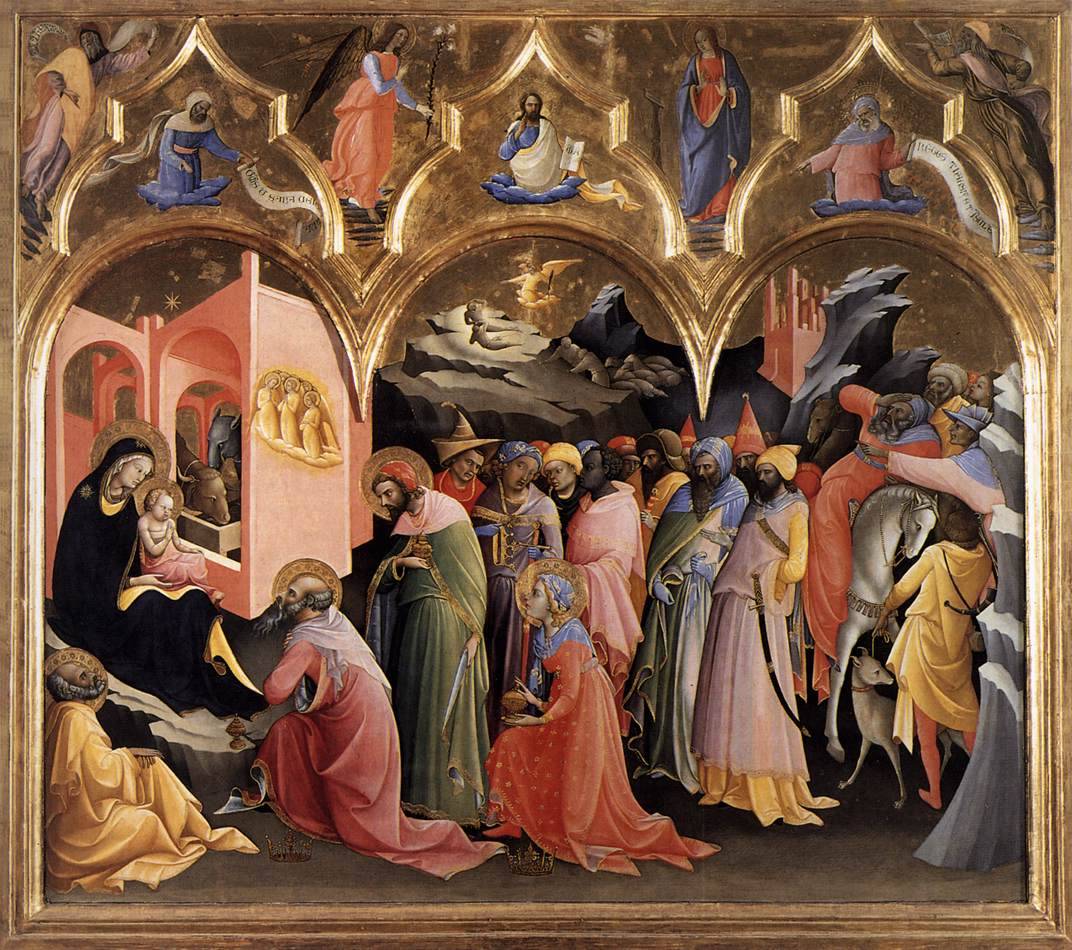Adoration of the Magi
Lorenzo Monaco

The Adoration of the Magi is a tempera on panel painting by the Italian late Gothic artist Lorenzo Monaco, now housed in the Uffizi Gallery in Florence.
The painting is known by a rather complete documentation. It was
executed by Lorenzo with the help of three assistants, and, despite the
reduced size, it was paid the huge sum of 182 florins. According to some hints in Giorgio Vasari’s Lives of the Most Excellent Painters, it could have been executed for the church of Sant'Egidio in Florence, when it was reconsecrated by Pope Martin V.
Later it is documented in a room facing the cloister of the monastery of San Marco, where it was seen by Fra Angelico. A source from 1810 reports how the work was initially attributed to Fra Angelico himself.
- It was restored in 1995.
- Artist Lorenzo Monaco
- Year 1420–1422
- Medium Tempera on panel
- Dimensions 115 cm × 183 cm (45 in × 72 in)
- Location Uffizi Gallery, Florence
The painting includes a large composition with a rather reduced use
of a gilded background, a typical element of most Lorenzo’s works. The
upper part is in the form of a frame creating a triptych.
On the left is portrayed the nativity scene, within an architecture
showing Lorenzo’s refusal of the contemporary introduction of
geometrical perspective in art. The Madonna, wearing a dark blue garment
with three stars (symbols of virginity), is sitting on a stone and
showing the child to the spectators. St. Joseph is sitting in the lower
left corner and looking upwards.
The centre and right scenes are occupied by the Magi’s procession.
Differently from the Gospel tradition, they are not all portrayed as old
men, but with three different ages symbolizing the ages of man. Their
followers include a variety of ethnicities, from the Moors to the
Tatars, as well as animals such as hounds and camels. In the upper part
is a landscape of Giottoesque inspiration. The garments of the standing
Magi and the one next to him have writing in Arabic.
In the cusps are a Blessing Redemeer and, in the middle, two prophets. In the 15th century between the cusps were added two further prophets and an Annunciation, partly executed by Cosimo Rosselli.
🎁 🎁 🎁
Epiphany 🌟 Epiphanie
Les Rois Mages
Three Wise Men
 Lorenzo Monaco
Lorenzo Monaco
(circa 1370–circa 1425)
Les Rois Mages
Three Wise Men
Lorenzo Monaco (born Piero di Giovanni; c. 1370 – c. 1425) was an Italian painter of the late Gothic-early Renaissance age. He was born Piero di Giovanni in Siena. Little is known about his youth, apart from the fact that he was apprenticed in Florence. He was influenced by Giotto and his followers Spinello Aretino and Agnolo Gaddi.
In 1390 he joined the Camaldolese monastery of Santa Maria degli Angeli. He was thenceforth generally known as Lorenzo Monaco (English: "Lawrence the Monk"). In the 1390s he executed three panels of the Biblioteca Laurenziana for his convent.
Starting from around 1404 his works show the influence of the International Gothic, of Lorenzo Ghiberti's earliest works and of Gherardo Starnina. From this period is the Pietà in the Gallerie dell'Accademia
in Florence. His works, often over a gilded background, showed in
general a spiritual value, and usually did not feature profane elements.
In 1414 he painted the Coronation of the Virgin (now at the Uffizi),
characterized by a great number of saints and brilliant colors. In the
late part of his life, Lorenzo did not accept the early Renaissance
innovations introduced by artists such as Masaccio and Brunelleschi. This is visible in the Adoration of the Magi
of 1420–1422, where the now widespread geometrical perspective is
totally absent. Lorenzo's works remained popular in the 1420s, as
testified by the numerous commissions he received, such as the Stories of the Virgin in the Bartolini Salimbeni Chapel of Santa Trinita, one of his few frescoes.
 Lorenzo Monaco
Lorenzo Monaco(circa 1370–circa 1425)

No comments:
Post a Comment